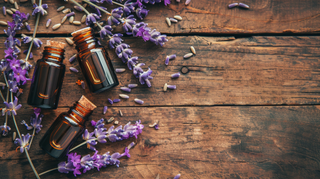As a naturopath with years of experience in holistic healing, I’ve seen how essential oils can influence mood and emotions. This guide will provide an look at how to use essential oils effectively for emotional balance and well-being.
Key Takeaways
| What are essential oils? | Highly concentrated plant extracts with potent aromatic compounds. |
|---|---|
| How do they influence emotions? | Through inhalation, affecting the limbic system, the brain's emotional center. |
| What are the benefits of using essential oils for emotional balance? | Can promote relaxation, reduce stress, uplift mood, and improve sleep quality. |
| How can I use essential oils safely and effectively? | Diffusion, dilution for topical application, and bath soaks are common methods. |

Essential Oils: The Science Behind the Scents
Essential oils are concentrated liquids extracted from various plant parts like flowers, leaves, and seeds. These potent liquids capture the plant's "essence" and boast a complex profile of aromatic compounds. When inhaled, these aromatic molecules travel directly to the olfactory bulb, a region in the nose with a direct connection to the limbic system – the brain's emotional control center. This unique pathway allows essential oils to bypass conscious thought and influence our emotions in profound ways.
Aromatic Allies for Emotional Wellbeing
The emotional benefits of essential oils are vast and well-documented. Here's a glimpse into how specific oils can target different emotional states:
-
Relaxation and Stress Relief: Lavender oil reigns supreme for its calming properties. Studies have shown its effectiveness in reducing anxiety and promoting restful sleep. Clary sage oil is another excellent choice, known to ease tension and uplift mood.
-
Mood Elevation and Focus: Feeling sluggish? Citrus oils like grapefruit and bergamot can invigorate the senses and promote feelings of alertness. Rosemary oil can enhance cognitive function and improve concentration.
- Emotional Upliftment: When feeling down, consider bergamot oil, with its uplifting and mood-boosting properties. Chamomile oil is another gentle option, promoting feelings of calmness and peace.
Essential Oil Applications: A Safe and Effective Approach
While essential oils offer a natural approach to emotional well-being, safe and proper use is paramount. Here are some common methods for incorporating essential oils into your self-care routine:
- Diffusion: Diffusers disperse essential oil particles into the air, allowing for inhalation and creating an aromatic ambiance.
- Dilution for Topical Application: Essential oils are highly concentrated and can irritate the skin if used undiluted. Always dilute them with a carrier oil like jojoba or almond oil before applying topically.
- Bath Soaks: Adding a few drops of essential oils to your bathwater can create a luxurious and relaxing experience.

Building Your Essential Oil Collection: Quality Matters
With the plethora of essential oils available, starting your collection can feel overwhelming. Here are some tips:
- Focus on Quality: Purchase your oils from reputable vendors who prioritize organic and therapeutic-grade essential oils.
- Start with a Few Basic Oils: Consider lavender, bergamot, and lemon as a versatile foundation for emotional well-being needs.
- Research and Experiment: As you gain experience, explore other essential oil options based on your specific emotional needs.
Safety Precautions: A Gentle Reminder
While generally safe for most individuals, essential oils can be potent. Here are some important safety considerations:
- Always dilute essential oils before topical application.
- Perform a patch test on a small area of your inner arm before using a new oil.
- Avoid contact with eyes and mucous membranes.
- Consult with a healthcare professional before using essential oils if you are pregnant, breastfeeding, or have any underlying medical conditions.
Essential Oil Blends for Emotional Harmony: Crafting Synergy
By combining different oils, you can achieve a synergistic effect, where the combined properties of the oils are greater than the sum of their parts. Here are some creative blends to target specific emotions:
-
De-Stress Blend: Combine 2 drops of lavender oil, 2 drops of bergamot oil, and 1 drop of clary sage oil in your diffuser for a calming and stress-relieving aromatic experience.
-
Focus and Clarity Blend: Feeling scattered? Diffuse a blend of 2 drops of rosemary oil, 2 drops of peppermint oil, and 1 drop of lemon oil to enhance concentration and mental clarity.
-
Uplifting Mood Blend: Combat feelings of sluggishness with a blend of 3 drops of grapefruit oil, 2 drops of bergamot oil, and 1 drop of ylang-ylang oil. This citrusy and floral combination can elevate mood and promote feelings of optimism.
- Peaceful Sleep Blend: Drift off to sleep with a relaxing blend of 3 drops of lavender oil, 2 drops of chamomile oil, and 1 drop of vetiver oil. Vetiver oil, known for its grounding properties, can further promote feelings of tranquility.
Remember: When creating your own blends, start with a few drops of each oil and adjust the ratios based on your preferences and the intensity of the aroma.
Essential Oil Safety: Beyond the Basics
While the previous section covered essential oil safety fundamentals, here are some additional points to consider:
-
Sun Sensitivity: Certain citrus oils, like grapefruit and bergamot, can increase sun sensitivity. Avoid sun exposure for several hours after topical application of these oils.
-
Pregnancy and Children: Essential oils should be used with caution during pregnancy and around children. Always consult with a healthcare professional before using essential oils in these situations.
- Pet Safety: Some essential oils can be toxic to pets. Do your research and avoid diffusing or topically applying oils around pets if there's any uncertainty.
A Final Note: A Holistic Approach to Emotional Well-being
While essential oils offer a valuable tool for emotional well-being, it's important to remember they are just one piece of the puzzle. For optimal emotional health, consider incorporating other holistic practices such as:
- Regular Exercise: Physical activity is a well-known mood booster and stress reliever.
- Mindfulness and Meditation: These practices can cultivate inner peace and emotional regulation.
- Healthy Sleep Habits: Prioritizing quality sleep is crucial for emotional well-being.
- Gratitude Practice: Focusing on gratitude can shift your perspective and promote positive emotions.
Blending essential oils for emotional balance involves understanding the unique properties of each oil and how they can influence our emotions. Here are some tips on how to blend essential oils for emotional balance:
-
Understand the Oils: Each essential oil has unique properties that can affect our emotions differently. For example, lavender is known for its calming properties, while peppermint can help reduce feelings of fatigue and boost energy.
-
Choose Your Oils: Based on your emotional needs, choose the oils that will best support your emotional balance. Some popular essential oils for emotional healing include lavender, ylang-ylang, bergamot, frankincense, patchouli, clary sage, and rose.
-
Blend the Oils: You can create a more personalized calming experience by blending essential oils together. For example, you might blend bergamot, ylang ylang, and frankincense.
- Use the Blend: There are various ways to use your essential oil blend. You can add a few drops to a diffuser to disperse the scent throughout a room, apply it topically (always diluted with a carrier oil to avoid skin irritation), or simply inhale the scent directly.
By combining aromatherapy with these holistic practices, you can create a comprehensive approach to emotional well-being and navigate life's challenges with greater resilience and emotional balance.
With a bit of knowledge and practice, you can start to incorporate these natural remedies into your daily routine for improved well-being.
Remember, it’s important to use essential oils safely and responsibly. Always dilute them before topical use, and if you’re pregnant, nursing, or have a medical condition, consult with a healthcare professional before use.









